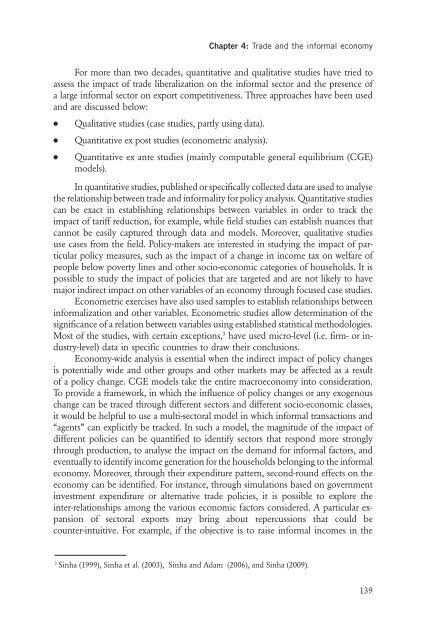Trade and Employment From Myths to Facts - International Labour ...
Trade and Employment From Myths to Facts - International Labour ...
Trade and Employment From Myths to Facts - International Labour ...
You also want an ePaper? Increase the reach of your titles
YUMPU automatically turns print PDFs into web optimized ePapers that Google loves.
For more than two decades, quantitative <strong>and</strong> qualitative studies have tried <strong>to</strong><br />
assess the impact of trade liberalization on the informal sec<strong>to</strong>r <strong>and</strong> the presence of<br />
a large informal sec<strong>to</strong>r on export competitiveness. Three approaches have been used<br />
<strong>and</strong> are discussed below:<br />
● Qualitative studies (case studies, partly using data).<br />
● Quantitative ex post studies (econometric analysis).<br />
Chapter 4: <strong>Trade</strong> <strong>and</strong> the informal economy<br />
● Quantitative ex ante studies (mainly computable general equilibrium (CGE)<br />
models).<br />
In quantitative studies, published or specifically collected data are used <strong>to</strong> analyse<br />
the relationship between trade <strong>and</strong> informality for policy analysis. Quantitative studies<br />
can be exact in establishing relationships between variables in order <strong>to</strong> track the<br />
impact of tariff reduction, for example, while field studies can establish nuances that<br />
cannot be easily captured through data <strong>and</strong> models. Moreover, qualitative studies<br />
use cases from the field. Policy-makers are interested in studying the impact of particular<br />
policy measures, such as the impact of a change in income tax on welfare of<br />
people below poverty lines <strong>and</strong> other socio-economic categories of households. It is<br />
possible <strong>to</strong> study the impact of policies that are targeted <strong>and</strong> are not likely <strong>to</strong> have<br />
major indirect impact on other variables of an economy through focused case studies.<br />
Econometric exercises have also used samples <strong>to</strong> establish relationships between<br />
informalization <strong>and</strong> other variables. Econometric studies allow determination of the<br />
significance of a relation between variables using established statistical methodologies.<br />
Most of the studies, with certain exceptions, 3 have used micro-level (i.e. firm- or industry-level)<br />
data in specific countries <strong>to</strong> draw their conclusions.<br />
Economy-wide analysis is essential when the indirect impact of policy changes<br />
is potentially wide <strong>and</strong> other groups <strong>and</strong> other markets may be affected as a result<br />
of a policy change. CGE models take the entire macroeconomy in<strong>to</strong> consideration.<br />
To provide a framework, in which the influence of policy changes or any exogenous<br />
change can be traced through different sec<strong>to</strong>rs <strong>and</strong> different socio-economic classes,<br />
it would be helpful <strong>to</strong> use a multi-sec<strong>to</strong>ral model in which informal transactions <strong>and</strong><br />
“agents” can explicitly be tracked. In such a model, the magnitude of the impact of<br />
different policies can be quantified <strong>to</strong> identify sec<strong>to</strong>rs that respond more strongly<br />
through production, <strong>to</strong> analyse the impact on the dem<strong>and</strong> for informal fac<strong>to</strong>rs, <strong>and</strong><br />
eventually <strong>to</strong> identify income generation for the households belonging <strong>to</strong> the informal<br />
economy. Moreover, through their expenditure pattern, second-round effects on the<br />
economy can be identified. For instance, through simu lations based on government<br />
investment expenditure or alternative trade policies, it is possible <strong>to</strong> explore the<br />
inter-relationships among the various economic fac <strong>to</strong>rs considered. A particular expansion<br />
of sec<strong>to</strong>ral exports may bring about repercussions that could be<br />
counter-intuitive. For example, if the objective is <strong>to</strong> raise informal incomes in the<br />
3 Sinha (1999), Sinha et al. (2003), Sinha <strong>and</strong> Adam (2006), <strong>and</strong> Sinha (2009).<br />
139

















